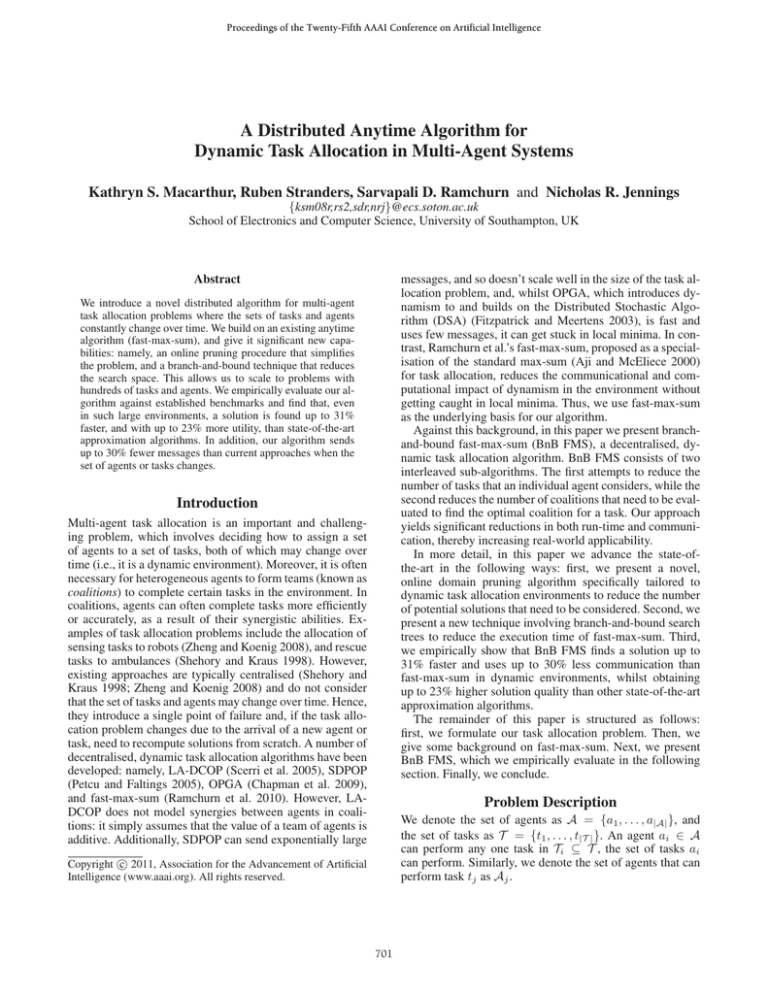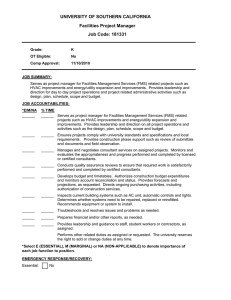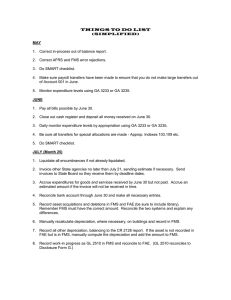
Proceedings of the Twenty-Fifth AAAI Conference on Artificial Intelligence
A Distributed Anytime Algorithm for
Dynamic Task Allocation in Multi-Agent Systems
Kathryn S. Macarthur, Ruben Stranders, Sarvapali D. Ramchurn and Nicholas R. Jennings
{ksm08r,rs2,sdr,nrj}@ecs.soton.ac.uk
School of Electronics and Computer Science, University of Southampton, UK
messages, and so doesn’t scale well in the size of the task allocation problem, and, whilst OPGA, which introduces dynamism to and builds on the Distributed Stochastic Algorithm (DSA) (Fitzpatrick and Meertens 2003), is fast and
uses few messages, it can get stuck in local minima. In contrast, Ramchurn et al.’s fast-max-sum, proposed as a specialisation of the standard max-sum (Aji and McEliece 2000)
for task allocation, reduces the communicational and computational impact of dynamism in the environment without
getting caught in local minima. Thus, we use fast-max-sum
as the underlying basis for our algorithm.
Against this background, in this paper we present branchand-bound fast-max-sum (BnB FMS), a decentralised, dynamic task allocation algorithm. BnB FMS consists of two
interleaved sub-algorithms. The first attempts to reduce the
number of tasks that an individual agent considers, while the
second reduces the number of coalitions that need to be evaluated to find the optimal coalition for a task. Our approach
yields significant reductions in both run-time and communication, thereby increasing real-world applicability.
In more detail, in this paper we advance the state-ofthe-art in the following ways: first, we present a novel,
online domain pruning algorithm specifically tailored to
dynamic task allocation environments to reduce the number
of potential solutions that need to be considered. Second, we
present a new technique involving branch-and-bound search
trees to reduce the execution time of fast-max-sum. Third,
we empirically show that BnB FMS finds a solution up to
31% faster and uses up to 30% less communication than
fast-max-sum in dynamic environments, whilst obtaining
up to 23% higher solution quality than other state-of-the-art
approximation algorithms.
The remainder of this paper is structured as follows:
first, we formulate our task allocation problem. Then, we
give some background on fast-max-sum. Next, we present
BnB FMS, which we empirically evaluate in the following
section. Finally, we conclude.
Abstract
We introduce a novel distributed algorithm for multi-agent
task allocation problems where the sets of tasks and agents
constantly change over time. We build on an existing anytime
algorithm (fast-max-sum), and give it significant new capabilities: namely, an online pruning procedure that simplifies
the problem, and a branch-and-bound technique that reduces
the search space. This allows us to scale to problems with
hundreds of tasks and agents. We empirically evaluate our algorithm against established benchmarks and find that, even
in such large environments, a solution is found up to 31%
faster, and with up to 23% more utility, than state-of-the-art
approximation algorithms. In addition, our algorithm sends
up to 30% fewer messages than current approaches when the
set of agents or tasks changes.
Introduction
Multi-agent task allocation is an important and challenging problem, which involves deciding how to assign a set
of agents to a set of tasks, both of which may change over
time (i.e., it is a dynamic environment). Moreover, it is often
necessary for heterogeneous agents to form teams (known as
coalitions) to complete certain tasks in the environment. In
coalitions, agents can often complete tasks more efficiently
or accurately, as a result of their synergistic abilities. Examples of task allocation problems include the allocation of
sensing tasks to robots (Zheng and Koenig 2008), and rescue
tasks to ambulances (Shehory and Kraus 1998). However,
existing approaches are typically centralised (Shehory and
Kraus 1998; Zheng and Koenig 2008) and do not consider
that the set of tasks and agents may change over time. Hence,
they introduce a single point of failure and, if the task allocation problem changes due to the arrival of a new agent or
task, need to recompute solutions from scratch. A number of
decentralised, dynamic task allocation algorithms have been
developed: namely, LA-DCOP (Scerri et al. 2005), SDPOP
(Petcu and Faltings 2005), OPGA (Chapman et al. 2009),
and fast-max-sum (Ramchurn et al. 2010). However, LADCOP does not model synergies between agents in coalitions: it simply assumes that the value of a team of agents is
additive. Additionally, SDPOP can send exponentially large
Problem Description
We denote the set of agents as A = {a1 , . . . , a|A| }, and
the set of tasks as T = {t1 , . . . , t|T | }. An agent ai ∈ A
can perform any one task in Ti ⊆ T , the set of tasks ai
can perform. Similarly, we denote the set of agents that can
perform task tj as Aj .
c 2011, Association for the Advancement of Artificial
Copyright Intelligence (www.aaai.org). All rights reserved.
701
Now, the value of coalition Cj ∈ 2Aj performing task tj
is denoted V (Cj , tj ) ∈ R+ . As we said earlier, this value
is not necessarily additive in the capabilities of the agents
in Cj . Since task tj cannot be performed with no agents
assigned to it, V (∅, tj ) = 0, ∀tj ∈ T . Moreover, we define
the contribution of ai to tj as δj (ai , Cj ), if coalition Cj performs tj , where δj (ai , Cj ) = V (Cj , tj ) − V (Cj \ {ai }, tj ).
Given this, and assuming that task utilities are independent, our objective is to find the coalition structure
∗
S ∗ = {C1∗ , . . . , C|T
| } which maximises the global utility:
S ∗ = arg max
S
V (Cj , tj )
we assume that the computation of function nodes has been
distributed amongst the agents.1
Thus, in factor graph notation, the objective function
given in Equation 1 is as follows: to find the variable assignment x∗ which maximises the global utility:
x∗ = arg max
x
fj (xj )
(3)
fj ∈F
Now that we have formulated the task allocation problem as
a factor graph, we can apply FMS, which solves Equation 3
in a decentralised fashion by exchanging messages between
the nodes in N — we extend these messages later. The message sent from function fj to variable xi is as follows:
(1)
Cj ∈S
rj→i (xi ) for xi = tj and any xi = tj where:
⎡
⎤
rj→i (xi ) = max ⎣fj (xj ) +
qk→j (xk )⎦
where S denotes the set of all coalition structures, and
subject to the constraint that no coalition overlaps (i.e., no
agent does more than one task at a time):
Cj ∩ Ck = ∅, ∀Cj , Ck ∈ S, j = k
(2)
xj \xi
The state space that Equation 1 covers is potentially very
|A|
large, i.e. i=1 |Ti |. However we can exploit the fact that
Ti = T , i.e., the problem is factorisable, and ensure that
there is no dependence on a central entity by decentralising
computation. To this end, we extend the fast-max-sum
algorithm, described in the next section.
(4)
xk ∈xj \xi
This message consists of two values: where xi is assigned
to tj , and where it is not. When a variable receives such a
message from a function, it responds by sending an updated
qi→j message to each of its neighbours, as follows:
qi→j (xi = tj ) = q and qi→j (xi = tj ) = q where:
q=
Fast-Max-Sum
rk→i (xi = −tk )
∈F \j
fk
i
⎡
To find solutions to our task allocation problem, we build
upon and extend fast-max-sum (FMS) (Ramchurn et al.
2010), which extends a particular algorithm from the Generalised Distributive Law (GDL) family (Aji and McEliece
2000), known as max-sum. FMS exploits a particular formulation of task allocation environments to greatly reduce
the message size and computation required when applying
max-sum in dynamic environments.
In more detail, we can model Equation 1 as a factor graph
(Kschischang, Frey, and Loeliger 2001): a bipartite, undirected graph, G = N , E. A factor graph consists of a set
of nodes N = F ∪ X , which consists of two types of nodes:
function nodes (factors), F, and variable nodes, X . In addition, the factor graph has a set of edges E, which represent
which variables are dependencies of which functions. The
task allocation problem can be represented as a factor graph,
by modelling an agent ai as a variable xi , which represents
the task that the agent will perform. Thus, xi takes values
in Ti . We can restrict how much of each variable’s domain
is represented within functions: since V (Cj , tj ) = 0 where
Cj = ∅, we need only represent an agent being assigned to
a specific task, and not being assigned to that task. This is
specialised to task allocation, unlike max-sum, where each
function is computed for each possible variable state. Thus,
each coalition value function, V (Cj , tj ), is represented by
a function fj (xj ), which operates over domain xj , where
xj represents which agents are assigned to tj : for example,
{(x1 = tj ), (x2 = tj ) . . .}, where (xi = tj ) ∈ xj is equivalent to ai ∈ Cj . Therefore, V (Cj , tj ) = fj (xj ). We do
not need to explicitly represent a variable’s state if it is not
assigned to tj , since δj (ai , Cj ) = 0 where ai ∈ Cj : task tj
is not concerned with which agent is assigned to which task,
only which agents are assigned to tj . It should be noted that
q = max ⎣rb→i (xi = tb ) +
tb =tj
⎤
rk→i (xi = tk )⎦
fk ∈Fi \fb ,fj
(5)
where Fi = {fj |tj ∈ Ti } and tb ∈ Ti \ tj . Again, the
function only considers the utility gained for xi = tj and
xi = tj . These messages continue to be passed, until their
values no longer change (i.e., the algorithm has converged).2
Nevertheless, to choose its value, the variable computes its
marginal function, zi (xi = tj ) as follows:
⎛
zi (xi = tj ) = ⎝rj→i (xi = tj ) +
⎞
rk→i (xi = tk )⎠
fk ∈Fi \fj
(6)
In so doing, we obtain the total utility for all states
of the variable. Then, the variable’s value is found with
arg maxxi zi (xi ).
By only considering xi = tk and xi = tk , FMS reduces
the communicated domain size of each variable from d to
2, compared to a naı̈ve implementation of max-sum. Hence,
the computational complexity of a factor with n variables
of domain size d in FMS is O(2n ), in contrast to O(dn )
required by naı̈vely applying max-sum to the same environment. However, the overall worst case computational complexity of FMS is O(|F| × 2dmax ), where dmax is the maximum arity of a function — i.e., the maximum number of
agents that could complete a task in the environment. Hence,
evaluating each factor remains the key bottleneck of FMS.
1
An allocation that balances the computational load among
agents might be desirable, but is beyond the scope of this paper.
2
Convergence is only guaranteed on acyclic factor graphs.
However, strong empirical results (Farinelli et al. 2008) exist that
show max-sum finds good quality solutions on cyclic graphs.
702
Branch-and-Bound Fast-Max-Sum
Algorithm 2 ODP at variable xi .
1: Procedure STARTUP ()
2: T̃i = Ti // Initialise modified domain
3: Δ = ∅ // Initialise stored bounds
4: Send ADD to all fj where tj ∈ T̃i .
5: Procedure: On receipt of δj (xi )ub , δj (xi )lb message from fj
6: if tj ∈ Ti then
7: Ti ← Ti ∪ tj // Add to domain
8: T̃i ← T̃i ∪ tj // Add to modified domain
9: if δj (xi )ub , δj (xi )lb ∈ Δ then
10: Δj = δj (xi )ub , δj (xi )lb .
11: if ∃Δk , ∀fk where tk ∈ T̃i . then
12:
while ∃tj ∈ Ṽi : δj (xi )ub < maxt ∈T̃ δk (xi )lb do
i
k
13:
T̃i ← T̃i \ tj // Remove from domain
14:
Δ ← Δ \ Δj // Remove from stored bounds
15:
Send PRUNE to tj
16: Procedure: ai can no longer perform tj
17: Ti ← Ti \ tj
18: if tj ∈ T̃i then // Removed task has not been pruned
19: Send ADD to all fk where tk ∈ Ti ∩ T̃i
20: T̃i ← Ti // Start pruning again
In order to combat this key bottleneck of FMS and enable it to scale effectively in the number of agents and
tasks, it is crucial to use techniques that reduce the size of
the state space explored: by reducing the number of tasks
and coalitions considered, whilst ensuring that such techniques remain both effective and efficient as the environment
changes. In doing this, we create an efficient, decentralised
task allocation algorithm for use in dynamic environments.
Our approach is similar to that of BnB MS (Stranders et
al. 2009). However, the key difference is that we explicitly
cater for environments that change over time, whereas BnB
MS would need to be completely re-run after every change
in the environment, as we show later. Moreover, BnB MS
is based on max-sum, and thus incurs additional communication and computation needed to search through full variable domains, as opposed to exploiting the ability to use binary values in task allocation environments, as we showed
earlier. Thus, in this section, we present branch-and-bound
fast-max-sum (BnB FMS), which addresses the shortcomings of FMS and BnB MS to produce a novel, scalable, dynamic task allocation algorithm. To do this, we remove tasks
that an agent should never perform with our online domain
pruning algorithm (ODP), and interleave this with optimising Equation 6 using branch-and-bound and FMS.
This allows bound computation to be less computationally expensive than re-computing messages such as those in
Equations 4 and 5, as the values of messages such as these
rely on messages received from others. Thus, whilst there
does exist a tradeoff between computing these bounds in order to reduce the complexity of FMS, and simply running
FMS, we show in our empirical evaluation that, in practice,
running ODP and FMS is much faster than just using FMS.
As mentioned above, contribution bounds can be used to
find any variable states which will never give a significant
enough gain in utility. We call such states dominated states.
Thus, in this phase, we use localised message-passing to find
and remove dominated states from variable domains. In addition, we recognise that changing variable domains (and
addition and removal of variables themselves) may change
which states are dominated, and we specifically cater for
this by maintaining and updating state information for each
variable, only passing new messages when they are absolutely necessary. Moreover, we show that this phase prunes
all dominated states and never compromises solution quality.
In more detail, we define dominated variable states as
those that can never maximise Equation 1, regardless of
what others do. Formally, at variable xi , task tj is dominated
if there exists a task t∗ such that:
Online Domain Pruning
As we mentioned earlier, the functions we consider represent the utility gained from using coalitions of agents to perform tasks. This allows us to compute a variable’s contribution to a function for a given task, as part of a particular
variable assignment. Now, if we sum the contributions of
all (xi = tj ) in a particular xj , we obtain fj (xj ). Hence,
these contribution values can be used to locally compute
which variable states (if any) will never provide a significant
enough gain in utility. This is achieved by computing exact
upper and lower bounds on each variable’s contributions.
Algorithm 1 ODP at function fj
1:
2:
3:
4:
5:
6:
7:
8:
Procedure SEND P RUNING M ESSAGE T O (xi )
Compute δj (xi )ub and δj (xi )lb
Send δj (xi )ub , δj (xi )lb to xi .
Procedure: On receipt of PRUNE from xi
Xj ← Xj \ xi // Remove from domain
Procedure: On receipt of ADD from xi
Xj ← Xj ∪ xi // Add to domain
Run procedure SEND P RUNING M ESSAGE T O (xk ) for all xk ∈ Xj
δj (xi , x−i ∪ (xi = tj )) ≤ δ ∗ (xi , x−i ∪ (xi = t∗ )), ∀x−i ∈ X
(7)
where x−i represents the state of all variables excluding xi ,
and X is the set of all possible joint variable states for x−i .
We can decentralise the computation of these dominated
states through local message-passing, as described in Algorithms 1 and 2, where, at a variable, Δ represents the stored
contribution bounds received from functions, and T̃i represents a variable’s modified domain — i.e., with values removed when pruned. Storing the received bounds and modified domains allows ODP to run online, as a variable can
update this domain in response to changes in the environment using both newly- and previously-received bounds (as
we will discuss later). This is different to (Stranders et al.
In more detail, we compute the upper bound on the contribution of xi to fj as δj (xi )ub = maxxj δj (xi , xj ). Similarly, we compute the lower bound on xi ’s contribution
to fj by δj (xi )lb = minxj δj (xi , xj ). Hence, δj (xi )ub ≥
δj (xi )lb , ∀fj ∈ Fi , xi ∈ X . We can compute these bounds
for any arbitrary function simply by using brute force, or by
analytically deriving specific bounds for the specific value
function used. The computational impact of computing these
bounds by brute force can be mitigated by caching the
bounds for a function so they need only be computed once.
703
2009), where variable domains would have to be completely
restored and the algorithm re-run after every change in the
environment, incurring potentially unnecessary overheads.
In more detail, ODP begins at the variables (lines 1–4,
Algorithm 2), which make a copy of their domains so that
they can keep track of their pruned domain as well as their
full domain (so that it can be restored after a change, if
needed), and announce which tasks they can perform. When
a function receives one of these announcements, it will send
upper and lower contribution bounds (Algorithm 1, lines 6–
8), which the variable uses to update its domain (if needed)
and stored bounds (lines 5–10, Algorithm 2). Next, if the
variable is aware of the bounds on its contribution to every
task it can perform (i.e., has stored bounds for every task in
its domain) then it can begin searching for dominated states.
If any dominated states are found, then they are removed
from the modified domain, and functions representing those
states are informed (lines 11–15, Algorithm 2). In response,
the functions will update their own domains. Below, we
prove that ODP will never prune an optimal state, under
the assumption that an agent’s optimal state only changes if
there is a change in the environment.
joint variable state space that needs to be explored. Now,
as given earlier, in Equation 4, the maximisation at a factor is a computational bottleneck, because a function node
fj must enumerate all 2|Tj | valid states and choose the
one with the maximum utility. Stranders et al. (2009) use
a similar technique to this, but do not exploit the fact that
V (∅, tj ) = 0, ∀tj ∈ T , instead considering every possible
state a variable can take. In contrast, we specialise this to
task allocation and reduce the size of the search tree by only
considering whether or not an agent is assigned to a task.
In this phase, we use search trees to prune joint states
from the state space being explored at each function in the
factor graph. To reduce this state space, we build a search
tree, where each node is a partial joint state x̂ (where some
variable states are not yet set), and leaf nodes are full joint
states (where the values of all variables are set). We apply
branch-and-bound on this search tree by computing the maximum value that can be gained from each branch (combining
both utility and received messages), and pruning dominated
branches. To do this, we first rename the expression in brackets from Equation 4 as r̃, so that message r is:
rj→i (xi ) for xi = tj and any xi = tj where:
rj→i (xi ) = max r̃j→i (xj )
Theorem 1. ODP never prunes optimal states from T̃i .
(8)
xj \xi
Proof. Let t∗ be the optimal state of xi . To prune t∗ from
T̃i , there must exist at least one tj ∈ Ti \ t∗ where Equation
7 holds. However, by definition, t∗ is xi ’s optimal state if
Equation 7 holds for all tk ∈ Ti \ t∗ . Therefore, it is impossible for such a tj to exist, and t∗ can never be pruned.
where:
r̃j→i (xj ) = fj (xj ) +
qk→j (xk )
(9)
xk ∈Xj \xi
Hence, we wish to find maxxj \xi r̃j→i (xj ).
Therefore, since ODP cannot prune an optimal state from
T̃ , it follows that ODP can never prune all states from T̃ .
Given this, ODP will always converge to a point where no
more states can be pruned.
Once the algorithm has completed, BnB FMS begins execution (as described in the next section). However, if xi
detects that it can no longer perform task tj , then tj is removed from xi ’s domain and updated domain (lines 16–20).
If xi had previously pruned tj from T̃i during ODP, then no
further messages need to be sent. However, if tj was in T̃i
after ODP this means that tj could have been xi ’s optimal
state, so xi must re-add any previously removed states to T̃i ,
and re-send ADD messages in case the removal of tj has
impacted which states are dominated. After each of these
steps, the operation of BnB FMS continues.
Algorithm 3 Online Joint State Pruning at function fj
BnB FMS
We give our online branch and bound algorithm in Algorithm 3 (specifically, procedure FIND M AX), and explain it
below. First, we construct our search tree (line 2): rooted at
x̂r = {−, . . . −, xi , −, . . . , −}, where − indicates an unassigned variable, xi is the variable that the message is being
sent to — i.e., the state that is fixed for that message. Then,
in line 6, we choose the first unassigned variable in x̂r (say,
x1 ), and create a branch of the tree for each possible value
of that variable — in our formulation, this would form two
more partial states, {(x1 = tj ), −, . . . −, xi , −, . . . , −} and
{(x1 = tj ), −, . . . −, xi , −, . . . , −} (line 7). Next, we estimate upper and lower bounds on the maximum value of
r̃j→i (x̂) that can be obtained by further completing the partial state for each subtree (line 8). In more detail, the upper
1:
2:
3:
4:
5:
6:
7:
8:
procedure FIND M AX (xi )
x̂r = {−, . . . −, xi , −, . . . , −}
Return EXPAND T REE (x̂r )
procedure EXPAND T REE (x̂)
if x̂ is not fully assigned then
xk = first unassigned variable in x̂
x̂true = x̂ ∪ (xk = tj ); x̂f alse = x̂ ∪ (xk = tj )
Compute r̃j→i (x̂true )ub , r̃j→i (x̂true )lb , r̃j→i (x̂f alse )ub
r̃j→i (x̂f alse )lb
9: if r̃j→i (x̂true )ub < r̃j→i (x̂f alse )lb then
10:
Return EXPAND T REE (x̂f alse )
11: else if r̃j→i (x̂f alse )ub < r̃j→i (x̂true )lb then
12:
Return EXPAND T REE (x̂true )
13: else
14: Return r̃j→i (x̂)
Once ODP has completed, if, for any xi , |T̃i | > 1 (i.e., pruning was unable to solve the problem completely), then xi
will begin the execution of FMS by sending q messages as
described in Equation 5. However, if |T̃i | = 1, then FMS
does not need to be run at xi , as the domain has been pruned
to the solution. If FMS does need to be run, then the agent
proceeds with FMS when it receives r messages (see Equation 4) from its neighbours.
The final element of our algorithm is the use of branchand-bound search in FMS: specifically, when a function
node is performing its maximisation in order to reduce the
704
and
(b) Wall time.
(a) Utility.
(c) States pruned.
Figure 1: Empirical Results: Scalability and Solution Quality.
bound is computed as follows:
r̃j→i (x̂)ub = fj (x̂)ub + q̃(x̂)ub
Therefore, under BnB FMS, the joint state chosen at each
agent in response to the messages they have received will
always be locally optimal.
(10)
where fj (x̂)ub is found, depending on the function, by brute
force or otherwise, and q̃(x̂)ub is computed as:
q̃(x̂)
ub
=
qk→j (x̂k ) +
x̂k ∈Xj \i,
x̂k =−
x̂k ∈Xj \xi ,
x̂k =−
max
xk ∈tj ,t−j
Empirical Evaluation
To empirically determine the savings brought about by BnB
FMS, we conducted two sets of experiments: to demonstrate
scalability and solution quality, and to evaluate communicational savings in response to dynamism, to show that our
algorithm is applicable in real-world task allocation environments. We compare BnB FMS to state-of-the-art algorithms
mentioned earlier, namely DSA (Fitzpatrick and Meertens
2003), SDPOP (Petcu and Faltings 2005), FMS (Ramchurn
et al. 2010), and OPGA (Chapman et al. 2009). We compare
to BnB MS only in the dynamism experiments, since FMS
has already been shown to achieve the same utility as
max-sum, with less computation (Ramchurn et al. 2010).
qk→j (xk )
(11)
where t−j indicates any value other than tj . Similarly, we
compute the lower bound as follows:
r̃j→i (x̂)lb = fj (x̂)ub + q̃(x̂)lb
(12)
where fj (x̂)ub is, again, either found by brute force or otherwise, and q̃(x̂)lb is computed as:
q̃(x̂)lb =
x̂k ∈Xj \i,
x̂k =−
qk→j (x̂k ) +
x̂k ∈Xj \xi ,
x̂k =−
min
xk ∈tj ,t j
qk→j (xk )
(13)
Scalability and Solution Quality
With these bounds, any branch where the upper bound for
x̃true is lower than the lower bound for x̃f alse , or the upper bound for x̃f alse is lower than the lower bound for x̃true
can be pruned (represented in Algorithm 3 lines 11–14 by
not expanding pruned branches). The algorithm proceeds by
expanding the next unassigned variable in the partial joint
state represented by the remaining branch of the tree (line
6), and computing lower and upper bounds on the children.
If possible, branches will be pruned, and so on, until we arrive at the leaves of the tree (where upper and lower bounds
will be equal), which represent complete joint variable states
(line 13), and we have found the joint state with the maximum utility (line 14). Next, we prove that this phase of BnB
FMS will not prune a locally optimal solution:
To evaluate the scalability and solution quality achieved
by BnB FMS, we generated 200 environments containing
|T | ∈ {50, 100, · · · , 500} and |A| = |T2 | , so that agents
don’t all end up being connected to the same few tasks.
We then generated links amongst agents and tasks to create
random graphs, trees, and scale-free graphs, for link density (average number of edges per node) d ∈ {3, 4, 5}. We
evaluate differing link densities because as the number of
links between tasks and agents increases, it becomes much
harder to find an allocation of agents to tasks, as per Equation 4. We define fj as a random coalition value function.
We ran each algorithm over all graphs, running |T | + |A| iterations of FMS and BnB FMS, and measured the wall time
of a synchronous implementation of each algorithm, utility
achieved, and the number of states pruned by BnB FMS. Our
results are plotted with 95% confidence intervals in Figure 1.
SDPOP (our optimal benchmark) exhausted available
memory even with 50 tasks and 25 agents, which was the
smallest environment under evaluation, so it is not plotted on
the graphs. Additionally, all algorithms performed, broadly,
the same, regardless of graph type and density, so we only
reproduce random graph results with d = 3 here. Figure
1(a) shows that, in terms of utility gained, BnB FMS outperforms DSA by up to 15% and OPGA by up to 23%, without
Theorem 2. A locally optimal joint state will not be removed from the search tree under Algorithm 3.
Proof. δj (xi = tj , xj ) = 0, ∀xj . Therefore, fj (xj ∪ (xi =
tk )) = fj (xj ∪ (xi = tl )), ∀xi ∈ Xj , k = l and k, l = j.
Hence, these binary values are representative of the entire
domains of xi ∈ X , and so all possible states of xi ∈ Xj
are covered by the search tree. Given this and the fact that
the bounds used are true upper and lower bounds, we can
guarantee that the optimal joint state will not be pruned from
the search tree.
705
because the number of messages sent is partially linked
to the number of states pruned from the graph, as pruning
states is equivalent to pruning edges in the factor graph.
This, again, demonstrates the scalability of BnB FMS.
Conclusions
In this paper, we presented BnB FMS, a distributed algorithm for task allocation. BnB FMS interleaves online
domain pruning with fast-max-sum and applies branch-andbound search when computing messages to be sent by a
function in order to prune the state space to be explored
further. Our empirical evaluation of BnB FMS shows that
it achieves up to 23% more utility than state-of-the-art
approximations. Solutions are found in up to 31% less time
than FMS (which achieves the same utility as BnB FMS),
and require at least 25% fewer messages than comparable
algorithms in dynamic environments. Our future work will
focus on bounding the quality of the solutions produced
by BnB FMS so that it can be used in environments where
theoretically provable solution quality is a key requirement.
Figure 2: Empirical Results: Dynamism.
sacrificing the good solution quality achieved by FMS (BnB
FMS and FMS gained the same utility, so the utility gained
by FMS is not plotted) and requires up to 31% less time than
FMS (Figure 1(b)). The times taken by DSA and OPGA
are very small (at most, 24 ms) and so are not plotted on
the graph: however, DSA and OPGA do not achieve as high
solution quality as FMS and BnB FMS, which take between
1s and 260s to run to achieve that quality.
In addition, in Figure 1 (c), we show the percentage of
states pruned by ODP for random and superadditive fj .
For both functions, pruning by ODP is affected only by
the structure of the function (around 15% more states are
pruned with a random function), not the size of the environment, as shown by the percentage of states removed being
constant. This demonstrates that FMS will always consider
more states than BnB FMS, demonstrating scalability.
Acknowledgments
This research was undertaken as part of the ALADDIN (Autonomous Learning Agents for Decentralised Data and Information Networks) Project and is jointly funded by a BAE
Systems and EPSRC (Engineering and Physical Research
Council) strategic partnership (EP/C 548051/1).
References
Aji, S. M., and McEliece, R. J. 2000. The generalized distributive
law. IEEE Trans. on Information Theory 46(2):325–343.
Chapman, A.; Micillo, R. A.; Kota, R.; and Jennings, N. R. 2009.
Decentralised dynamic task allocation: A practical game-theoretic
approach. In Proc. of AAMAS 2009, 915–922.
Farinelli, A.; Rogers, A.; Petcu, A.; and Jennings, N. R. 2008.
Decentralised coordination of low-power embedded devices using
the max-sum algorithm. In Proc. of AAMAS 2008, 639–646.
Fitzpatrick, S., and Meertens, L. 2003. Distributed coordination
through anarchic optimization. In Lesser, V.; Jr., C. L. O.; and
Tambe, M., eds., Distributed Sensor Networks: A Multiagent Perspective. 257–295.
Kschischang, F. R.; Frey, B. J.; and Loeliger, H. A. 2001. Factor
graphs and the sum-product algorithm. IEEE Trans. on Information
Theory 47(2):498–519.
Petcu, A., and Faltings, B. 2005. S-DPOP: Superstabilizing, Faultcontaining Multiagent Combinatorial Optimization. In Proc. of
AAAI 2005, 449–454.
Ramchurn, S. D.; Farinelli, A.; Macarthur, K. S.; and Jennings,
N. R. 2010. Decentralised Coordination in RobocupRescue. The
Computer Journal 53(9):1447–1461.
Scerri, P.; Farinelli, A.; Okamoto, S.; and Tambe, M. 2005. Allocating tasks in extreme teams. In Proc. of AAMAS 2005, 727–734.
Shehory, O., and Kraus, S. 1998. Methods for task allocation via
agent coalition formation. Artificial Intelligence 101:165–200.
Stranders, R.; Farinelli, A.; Rogers, A.; and Jennings, N. 2009.
Decentralised coordination of mobile sensors using the max-sum
algorithm. In Proc. of IJCAI 2009, 299–304.
Zheng, X., and Koenig, S. 2008. Reaction functions for task allocation to cooperative agents. In Proc. of AAMAS 2008, 559–566.
Coping with Dynamism
Our second experiment demonstrates the performance of
BnB FMS in a dynamic scenario, to compare the communication used to FMS, and running domain pruning after every
change (which is similar to what BnB MS does, so we call
it BnB MS). To do this, we generated 200 random graphs
as above, and performed n random changes3 on each graph
at each of 10 timesteps, where n is drawn from a Poisson
|
distribution for each timestep, with λ = |T
10 − 1, running
each algorithm at each timestep. We measured the sum of
messages sent over the entire execution, including preprocessing steps: we plot the messages sent by BnB FMS and
BnB MS as a percentage of those sent by FMS in Figure 2,
with 95% confidence intervals. Again, we found graph density and structure made no impact on the performance of the
algorithms, so we only reproduce results for a random graph
with d = 3 here. In addition, we found that varying λ produced similar results. Figure 2 shows that BnB MS sends up
to 23% fewer messages than FMS. As a result of specifically
catering for dynamic environments, BnB FMS sends 30%
fewer messages than FMS (10% fewer than BnB MS, using
much smaller messages), whilst, as shown earlier, achieving
the same utility as FMS in less time. In addition, the saving
in messages is almost constant as the environment grows,
3
Chosen uniformly from adding or removing an agent or task,
where existing tasks/agents are randomly selected and removed,
and new tasks/agents are created with connections to d randomlyselected tasks/agents.
706





